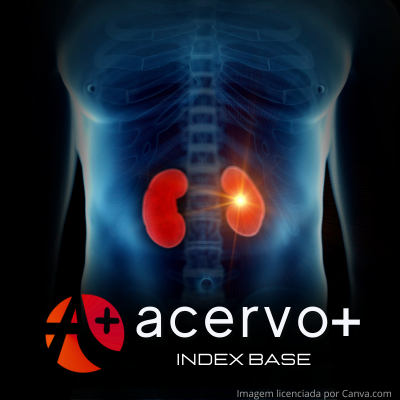Clinical management of grade IV renal injury with contralateral renal agenesis
Main Article Content
Abstract
Objective: To report a case of successful clinical management of a patient with grade IV renal injury and contralateral renal agenesis, highlighting the effectiveness of the conservative approach in preserving renal function. Case details: Male patient, 22 years old, victim of a car accident, arrived at the emergency room with signs of abdominal trauma, pain in the left flank, tachycardia and hypotension. He was stabilized with serum therapy and underwent indwelling bladder catheterization, which revealed macroscopic hematuria. Imaging tests confirmed grade IV renal injury in the left kidney and congenital absence of the right kidney. Given hemodynamic stability, conservative treatment was chosen, with admission to an intensive care unit for strict monitoring. The patient presented a favorable evolution, being discharged from hospital after 15 days. Within 30 days, a new urotomography demonstrated complete renal healing. Final considerations: Severe kidney trauma can result in severe complications, such as kidney failure and hypovolemic shock. Management depends on hemodynamic stability and tomographic evaluation. In hemodynamically stable patients, conservative treatment has been shown to be effective in preserving renal function. This case reinforces the importance of an individualized, non-surgical approach to reduce risks and ensure a better quality of life for the patient.
Article Details
Copyright © | All rights reserved.
The journal holds the exclusive copyright for the publication of this article under the terms of Brazilian law 9610/98.
Partial reproduction
The use of parts of the texts, figures and questionnaire of the article is free, being mandatory the citation of the authors and journal.
Total reproduction
It is expressly prohibited and must be authorized by the journal.
References
2. ASSEF JC, et al. Emergências cirúrgicas: traumáticas e não traumáticas, condutas e algoritmos. São Paulo: Atheneu, 2012; 1: 89-103.
3. AAST. ASSOCIAÇÃO AMERICANA PARA A CIRURGIA DO TRAUMA. Classificação de lesões renais. 2018. Disponível em: https ://www.aast.org/resources/guidelines. Acessado em: 31 de janeiro de 2025.
4. BJURLIN MA, et al. Genitourinary injuries in the era of nonoperative management: evaluation and management. Translational Andrology and Urology, 2019; 8(1): 14-28.
5. ERLICH T e KITREY ND. Renal trauma: the current best practice. Therapeutic Advances in Urology, 2018; 10(10): 295–303.
6. GERSTENBLUTH RE, et al. Evaluation and management of renal trauma: an overview. The Journal of Urology, 2002; 167(1): 37–45.
7. GERSTENBLUTH RE, et al. Sports participation and high grade renal injuries in children. Journal of Urology, 2002; 168(6): 2575-2578.
8. HELLER MT, et al. Imaging of genitourinary trauma. Radiologic Clinics of North America, 2019; 57(1): 15-29.
9. HOLEVAR M, et al. Practice management guidelines for the management of genitourinary trauma: The EAST Practice Management Guidelines Work Group. Chicago; 2004; 6.
10. JANKOWSKI JT, et al. The role of ultrasound in the assessment of blunt genitourinary trauma. The Journal of Trauma, 2006; 61(5): 1213-1218.
11. KEIHANI S, et al. Advanced imaging modalities in genitourinary trauma. Current Urology Reports, 2018; 19(9): 1-10.
12. MOORE EE, et al. Organ injury scaling: spleen, liver, and kidney. Journal of Trauma, 1989; 29(12): 1664–1666.
13. MOORE K, et al. Anatomia Orientada para a Clínica. 7ª ed. Rio de Janeiro: Guanabara Koogan; 2014; 364.
14. QUDAH A, et al. The significance of microscopic and gross hematuria in patients with blunt renal trauma. Urology Journal, 2006; 3(2): 65-69.
15. SANTUCCI RA e MCANINCH JM. Grade IV renal injuries: evaluation, treatment, and outcome, World J Surg, 2001; 25(12): 1565-1572.
16. SANTUCCI RA e MCANINCH JW. Blunt renal trauma: guideline for conservative management. The Journal of Urology, 2001; 166(1): 66–70.
17. SANTUCCI RA, et al. Evaluation and management of renal injuries: consensus statement of the renal trauma subcommittee. BJU International, 2004; 93(7): 937-954.
18. SCHMIDLIN F, et al. Biomechanical analysis and clinical treatment of blunt renal trauma. Swiss Surgery, 1998; (5): 237–243.
19. SERAFETINIDES E, et al. Imaging of renal trauma. European Journal of Radiology, 2015; 84(4): 556-567.
20. VOELZKE BB e LEDDY L. The epidemiology of renal trauma. Translational Andrology and Urology, 2014; 3(2): 143-149.
21. WESSELLS H, et al. Renal injury and operative management in the United States: results of a population-based study. Journal of Trauma, 2003; 54(3): 423-430.

